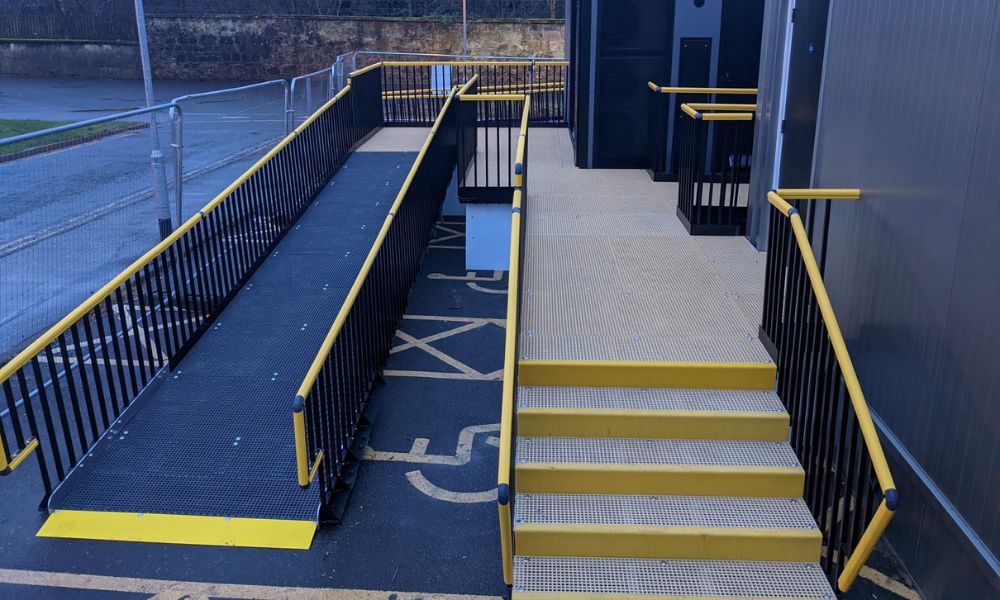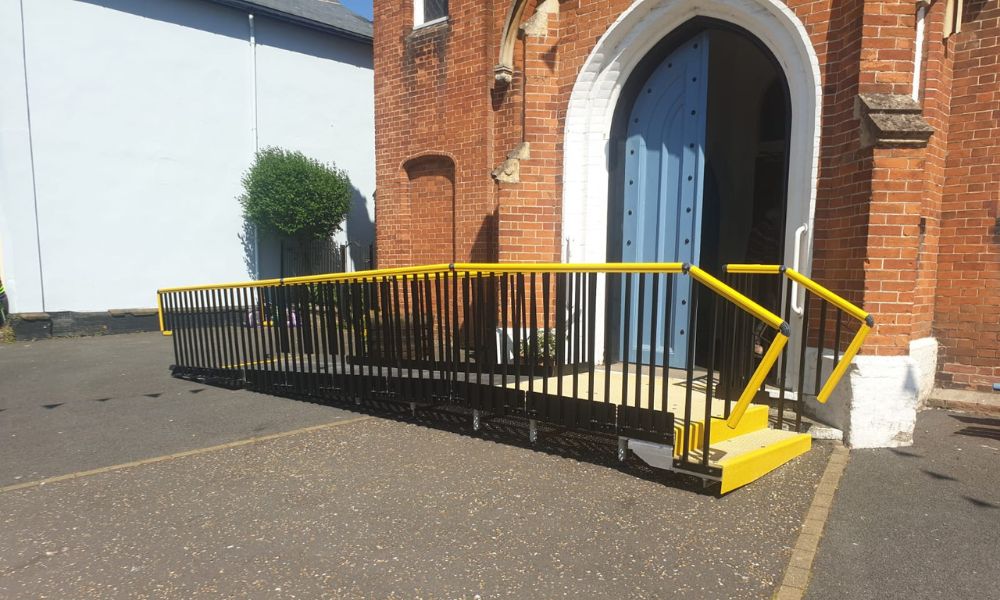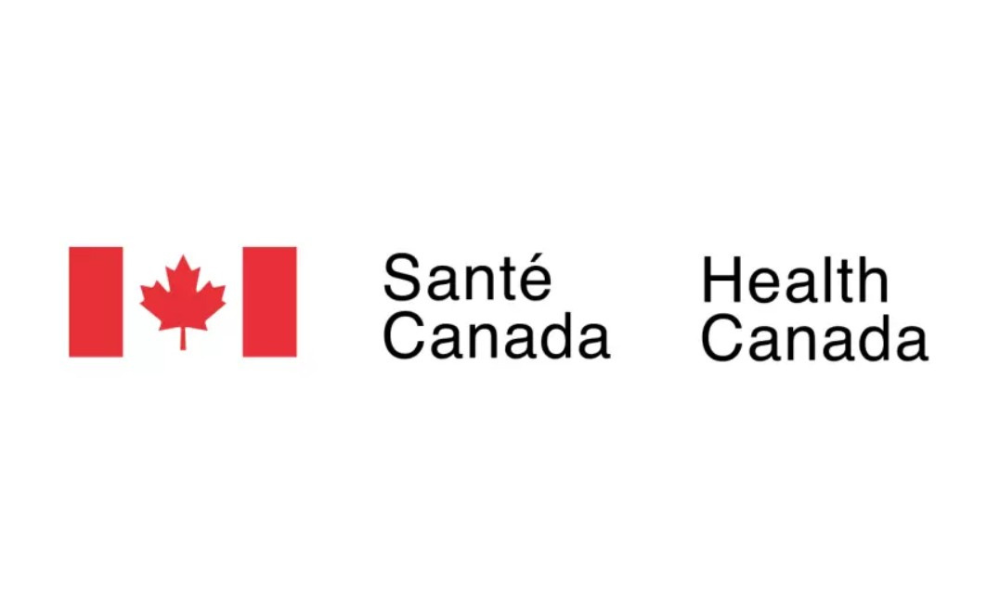How Kee Safety's modular ramps help businesses address Canada’s growing accessibility requirements

This article was created in partnership with Kee Safety
Most people don’t think about how they’ll get into — or, in the event of an emergency, out of — a building. Whether it’s work, a restaurant, or a corner store, those of us who are able-bodied simply walk in and out. But imagine you use a wheelchair or are visually impaired, and you can’t safely enter a building to apply for a job or have a meal because of a curb. It’s an issue Nick Bixcul, strategic solutions manager at Kee Safety, ran into while planning the company Christmas party last year.
Mindful of a colleague with accessibility issues, Bixcul reached out to multiple restaurants in downtown Toronto to ask about the access to their establishment. One after the other stated they had steps or steep curbs and no back-up plan for guests who couldn’t manage them, and it took over 30 phone calls to find one that was fully accessible.
“My colleague told me this is what they deal with all the time — we need to ask ourselves how it’s still a problem in 2024,” Bixcul says. “Accessibility is something everyone needs to be able to do, but we don’t consider it unless it’s an issue for us personally. That’s where the education piece comes in.”
Separating people from hazards
As per 2019’s Accessible Canada Act, Canada is intensifying its efforts to ensure cross-country accessibility standards and reinforce equal rights through inclusion, whether it be language signage, service animals, reserved seating on public transportation, or wheelchair ramps. Provinces are currently facing deadlines when it comes to meeting regulations, including Jan.1, 2025 for The Accessibility for Ontarians with Disabilities Act (AODA). While legally this issue is more pressing than ever, Bixcul argues that making sure your building is accessible is also simply the right thing to do.
Working at Kee Safety for over a decade, Bixcul lives and breathes the company’s motto: separating people from hazards. In his role, he works strategically with companies and organizations to identify hazards and find solutions that keep them away from their workforce. When it comes to accessibility, Bixcul suggests workplaces start addressing gaps by asking a simple question: how do I get in? Now, pretend you are pushing a stroller or in a wheelchair. Can you still get in safely? If the answer is no, “stop right there and look at the resources available to you,” he advises.

There are multiple angles to take when approaching these issues, and Bixcul underscores that the solutions don’t have to be complicated or expensive to be effective. While Kee Safety can come and perform a safety audit, he urges people to first step back and start with the basics. Understand the legislation — some parts of it may be open to interpretation, so give it a thorough read, he warns — and most importantly collaborate within their community. At the end of the day, the best way to be informed is through sharing experiences with others.
“There’s no secret sauce here. One of my mentors said to me, how do you eat an elephant? One bite at a time. Start somewhere and continue through it. Educate yourself, leverage relationships with others in the same situation, and consider all options. There are many ways to get things done.”
RightWay Pro ramps
There are simple measures to take that help people with any sort of impairment get into a building or facility, including Kee Safety’s recently launched new accessibility ramp. In line with its motto and national objectives, RightWay Pro was designed to assist businesses and communities adapt to changing requirements and the overall shift in societal expectations when it comes to accessibility.
Understanding a full-blown construction project on a building to add a permanent fixture may not be an option for some, Kee Safety created a modular safety ramp that meets AODA requirements and allows people of different abilities to get in safely. The fact that it has multiple configurations based on an individual business’ needs — it can be set up so it doesn’t extend into traffic, for example, or can wrap around the side of a building to not block the sidewalk, and is easily assembled and disassembled as required — is a critical advantage.

“We integrate the ramp as modular as possible so it’s easy for everyone,” Bixcul notes. “There are cost implications for clients who are trying to do a facelift or get their building up to code and wanted our product to address that pain point.”
The ramp is also durable, made of materials that will stand the test of time. Again, when investing in equipment, you want to ensure it’s a high-quality product that will last. The RightWay Pro ramps won’t tarnish or rust but keep its original look for several years, Bixcul says, adding that “we understand money doesn’t grow on trees and this can be an expensive venture, but it’s necessary.”
Kee Safety is more than willing to work with people to point them in the right direction, whether it’s extra resources, a product such as RightWay Pro, or government funding for another solution. It’s their mission to help.
“The bottom line is, not everybody gets in the door the same way so be considerate, be mindful,” Bixcul says. “We shouldn’t just look at the bare minimum of what constitutes a safe building. Think outside the industry and into the future — we need to ensure all our buildings are accessible for all Canadians.”





